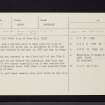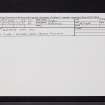Pricing Change
New pricing for orders of material from this site will come into place shortly. Charges for supply of digital images, digitisation on demand, prints and licensing will be altered.
Montrose, Fort Hill
Castle (Medieval)(Possible), Human Remains (Period Unknown), Well (Period Unknown)
Site Name Montrose, Fort Hill
Classification Castle (Medieval)(Possible), Human Remains (Period Unknown), Well (Period Unknown)
Alternative Name(s) Montrose Castle; Montrose, 62-4 Bridge Street; Montrose Infirmary
Canmore ID 36242
Site Number NO75NW 3
NGR NO 7102 5740
Datum OSGB36 - NGR
Permalink http://canmore.org.uk/site/36242
- Council Angus
- Parish Montrose
- Former Region Tayside
- Former District Angus
- Former County Angus
NO75NW 3 7102 5740
(Name NO 7102 5740) Site of Fort Hill (NAT)
OS 6" map (1938)
Fort Hill was a hillock said to have been the site of Montrose Castle (Statistical Account [OSA] 1793) which was in existence by 1178, was captured and reduced by Wallace in 1297 and was in ruins in 1488. The hillock was removed in the first half of the 19th century.
Local people do not favour the assertion that this was the site of the castle especially as it was outside the Royalty of Montrose until 1825 when it was acquired from the Barony of Dun.
Only a well and human remains were ever found on the hill.
Name Book 1858; A Jervise 1861.
NO 710 574. In April and May 1996 SUAT undertook trial work on the E side of Montrose Infirmary, in advance of construction of the A92 Montrose relief road. The objectives of the trial work were to assess any archaeological evidence relating to the royal castle, 16th-century fort and medieval backlands. Three trenches were machine excavated. Limited evidence of medieval backland occupation survived as features and deposits with medieval pottery and bone, and probably as truncated garden soils. No evidence was found for the defensive use of the site in the medieval/post-medieval period, the early castle or 16th-century fort. Further work was not required.
Sponsor: Angus Council Roads Department
R Cachart 1996.
Publication Account (1978)
Although its exact location is unclear a royal castle at Montrose dates to at least the reign of William the Lion. That monarch issued twenty charters from Montrose and at one point during his reign granted land to a man called Crane 'for the service of being a porter in the royal castle of Montrose' (Barrow, 1971, 476). One local historian believed that the early castle of Montrose was on Maryton Law adjoining the lands of Old Monros or further east (Low, 1930, 4). Other local worthies have cited Forthill as a possible early castle site. Forthill, a hillock, was located at the fort of Bridge Street and was largely destroyed in the early nineteenth century. Investigators from Ordnance Survey reported that 'local people do not like the assertion that this was the site of the castle as it was outside the royalty of Montrose until 1826' (Ordnance Survey, Record Cards, Reference No. 75 NW 3). The castle was reputedly destroyed during the Wars of Independence (Fraser, 1974, 81). The newly-created Duke of Montrose in the second half of the fifteenth century was granted the site of the Castle of Montrose, 'commonly called the Castlested' (Fraser, 1974, 81). The Duke of Montrose never constructed a castle on that site; however, workmen in 1950 found ancient brick foundations set upon slabs of stone which continued under the building at No. 5, Castle Place and gave the indication that they formed a single building. In one part was a circle of stone slabs not unlike a large boiler or the base of a small tower (Fraser, 1974, 82). It is believed that these foundations were those of a town house ac.quired by the Earls of Montrose in the sixteenth century (Fraser, 1957, 26).
A fort for defence against the English was hastily constructed in the late 1540s at Forthill. A French soldier described the fort as small with little space for storing provisions or keeping men. The fort furthermore was built on moving sands and was constructed solely of turf (Brown, 1891, 67). The Royal Infirmary now occupies the site (Fraser, 1974, 69).
Information from ‘Historic Montrose: The Archaeological Implications of Development’ (1978).










